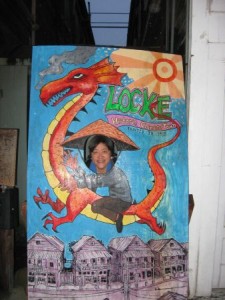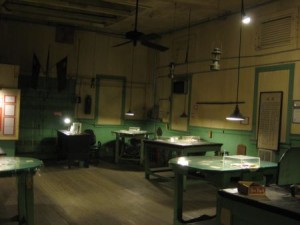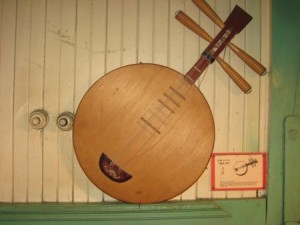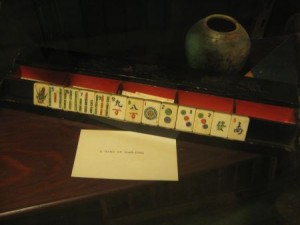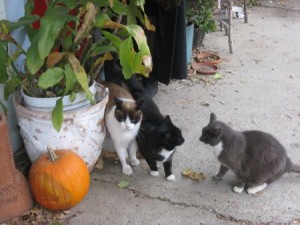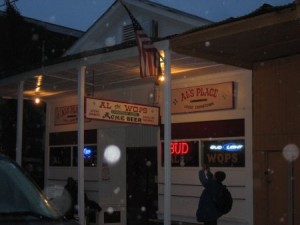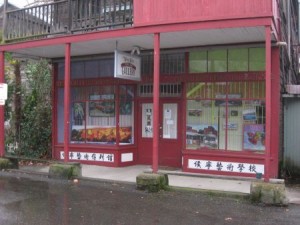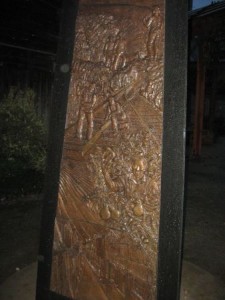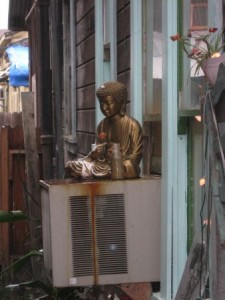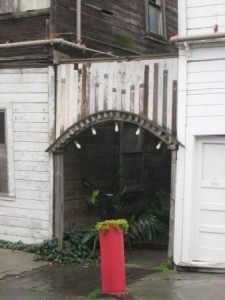Forty minutes into our road trip to Locke and Rio Vista, my front driver’s side tire went flat. I rolled off Highway 12, onto the shoulder, and got out to take a look. The tire was pretty flat. As I got back into the car to call AAA, a pickup truck pulled in ahead of us. Ray, who works for an auto glass company, saw we were in trouble and stopped to help. He had an air compressor and offered to put air into the tire. He did, and we both could hear the hissing as it rushed right back out. He also offered to spray a can of tire sealant into my tire, but then, he said, he saw the hole, and realized that wasn’t going to work. I called AAA and in about thirty minutes Miguel showed up. Young efficient, and friendly. He towed us to the Les Schwab in Napa. Miguel grew up on Vallejo but he lives in Napa now. He said the first rain of the season had led to a busy a day for him, including pulling a pickup truck out from under a power pole it hit. The pole cracked like a matchstick and fell on top of the truck.
A little more than an hour at Les Schwab, and we were on the road again, with a patched tire. Everyone, from the complete stranger Ray who stopped to see if we needed help, to Miguel, to the friendly and efficient folks as Les Schwab, were great.
*
This put us about an hour and a half behind schedule and it was starting to rain heavily as I drove out across the delta. The Sacramento River was pewter gray as we went over the Rio Vista Bridge.
Locke is now a state park. The town was founded in 1915 by Chinese laborers who had worked on the levees. In 1915 there was a serious fire in nearby Walnut Grove, burning most of the houses where the Chinese workers lived. Chinese were forbidden to own property, but they could own the buildings that they built on the land. The community made a deal with the Locke brothers, to lease an orchard they weren’t working. The laborers built houses and the town was born.
Over the decades the town thrived and ebbed, and in the 1970s and 1980s it was practically a ghost town. Once again the community got together and started rebuilding. They created the schoolhouse museum. eventually the state converted it to a state preserve, and now it is actually a park. There are three museums now on the two blocks of Main Street; the old casino, the Chinese Cultural Society Museum and the school house, which is flanked by a bust of Confucius and one of Dr. Sun Yat-Sen. The pictures below are from the casino.
*
The town has a large number of sleek and well-fed cats, many of whom have cropped ears. The lady who ran the Chinese medicine shop told us those were feral cats. They were pretty friendly — a gray and white one followed Lillian down the block and then came up to her again later. I’m sure the town of Locke is ninety-nine percent mouse-free.
*
The man who waited us on in the shop across from the school house owns the Locke Art Center. He was just helping out a friend. He is from Guanzhou (we used to call it Canton), and sells imported Chinese goods.
We asked if there were restaurants in town. He said there were two: Al the Wop’s Place (yes, that is the real name, and Al named it that) and “a Chinese place up the block.” Lillian had read about Al the Wop’s, which serves steaks and burgers. By now we were pretty wet and pretty cold, and a burger was sounding good. We went into Al’s, which opens into a dark bar that had about eight guys in it. Across the bar was the dining room. The burgers were good, cooked medium (we weren’t asked, that’s just how they came) and served on grilled sourdough bread, not a bun. The salad came with a house dressing that was somewhere between Thousand Island and Russian; tangy and sweet, not too thick and with none of the relish you sometimes find in Thousand Island. For most of our meal we were the only people in the dining room, but as we were finishing up, two couples came in. The jukebox started playing; “Fast Car” by Tracy Chapman. Really? It was followed by “Walkin’ After Midnight” by Patsy Kline, followed by not one but two Grateful Dead songs.
When we went outside (the gray cat greeted Lillian) it was twilight.
Before we stopped for dinner, we went into Strange Cargo, an antique shop/thrift store/ used book store with a huge collection of antiquarian California history books. Two men were hanging out, one behind the counter and one on our side, talking about fighter jets. Thomas and Ernie, they said, introducing themselves. They talked about the town a bit. Thomas is the owner of the book collection, and also part of the Locke historical society. Ernie is an artist and a musician. Thomas showed us two of Ernie’s landscapes (one done in chalk on black paper, very rich and atmospheric). Ernie said if we wanted to see a real artist Twe should go down the block to Ning Lu’s studio.
So after dinner I walked down there, but it was closed. Ning’s pictures were on display in the window, and they were lovely. He has a panoramic painting of the rim of the Grand Canyon.
Thomas and Ernie also gave us the history of the memorial park. A building close to the school house caught fire and burned down. Because they are in a state park, it is complicated if not impossible to build a new building. Originally they decided they would just do a small park with a picnic bench, but the more the townfolk talked about it, the more they decided they wanted something more, including the memorial and an arbor.
Of all the people who live in town now, only about ten of them are Chinese.
Locke in the rain looks worn and mysterious, a little bit as if you are stepping back in time.


